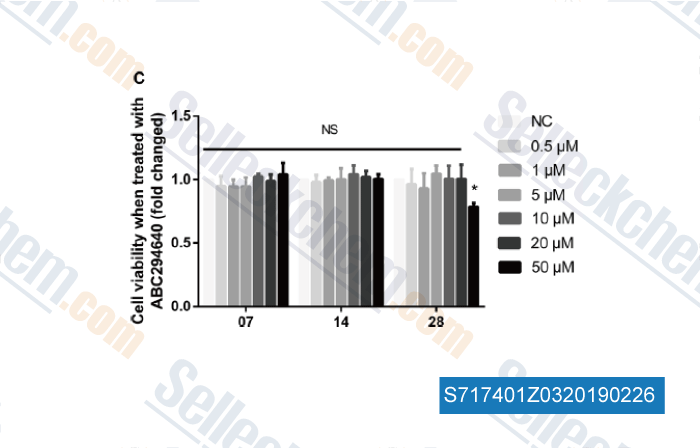|
Toll Free: (877) 796-6397 -- USA and Canada only -- |
Fax: +1-832-582-8590 Orders: +1-832-582-8158 |
Tech Support: +1-832-582-8158 Ext:3 Please provide your Order Number in the email. |
Technical Data
| Formula | C23H25ClN2O |
||||||
| Molecular Weight | 380.91 | CAS No. | 915385-81-8 | ||||
| Solubility (25°C)* | In vitro | DMSO | 76 mg/mL (199.52 mM) | ||||
| Ethanol | 28 mg/mL (73.5 mM) | ||||||
| Water | Insoluble | ||||||
| In vivo (Add solvents to the product individually and in order) |
|
||||||
|
* <1 mg/ml means slightly soluble or insoluble. * Please note that Selleck tests the solubility of all compounds in-house, and the actual solubility may differ slightly from published values. This is normal and is due to slight batch-to-batch variations. * Room temperature shipping (Stability testing shows this product can be shipped without any cooling measures.) |
|||||||
Preparing Stock Solutions
Biological Activity
| Description | Opaganib (ABC294640) is an orally bioavailable and selective sphingosine kinase-2 (SphK2) inhibitor with IC50 of approximately 60 μM. Phase 1/2. | ||
|---|---|---|---|
| Targets |
|
||
| In vitro | ABC294640 markedly alters the ratio of ceramide/S1P consistent with inhibition of SK activity in MDA-MB-231 cells. ABC294640 inhibits tumor cell proliferation with IC50 values ranging from approximately 6 to 48 μM, and impairs tumor cell migration concomitant with loss of microfilaments. [1] ABC294640 induces nonapoptotic cell death, morphological changes in lysosomes, formation of autophagosomes, and increases in acidic vesicles in A-498, PC-3, and MDA-MB-231 cells. [2] In both MCF-7 and ER-transfected HEK293 cells, ABC294640 decreases E2-stimulated ERE-luciferase activity. [3] | ||
| In vivo | In mice bearing mammary adenocarcinoma xenografts, ABC294640 (100 mg/kg, p.o.) significantly reduce tumor growth, associated with depletion of S1P levels. [1] In severe combined immunodeficient mice bearing A-498 xenografts, ABC294640 delays tumor growth and elevates autophagy markers. [2] ABC294640 protects against liver transplantation-induced inflammation and cross-talk between innate and adaptive immunities, major events precipitating and exacerbating graft injury, and improves liver function and survival. [4] |
Protocol (from reference)
| Kinase Assay:[1] |
|
|---|---|
| Cell Assay:[1] |
|
| Animal Study:[1] |
|
References
Customer Product Validation

-
Data from [Data independently produced by , , Inflammation, 2018, 41(4):1498-1507]
Selleck's Opaganib (ABC294640) has been cited by 24 publications
| Sphingosine kinase 1 promotes M2 macrophage infiltration and enhances glioma cell migration via the JAK2/STAT3 pathway [ Sci Rep, 2025, 15(1):4152] | PubMed: 39900970 |
| Comprehensive metabolomics expands precision medicine for triple-negative breast cancer [ Cell Res, 2022, 10.1038/s41422-022-00614-0] | PubMed: 35105939 |
| Injectable cartilage matrix hydrogel loaded with cartilage endplate stem cells engineered to release exosomes for non-invasive treatment of intervertebral disc degeneration [ Bioact Mater, 2022, 15:29-43] | PubMed: 35386360 |
| The central role of Sphingosine kinase 1 in the development of neuroendocrine prostate cancer (NEPC): A new targeted therapy of NEPC [ Clin Transl Med, 2022, 12(2):e695] | PubMed: 35184376 |
| The sphingosine kinase inhibitor SKI-V suppresses cervical cancer cell growth [ Int J Biol Sci, 2022, 18(7):2994-3005] | PubMed: 35541904 |
| The sphingosine kinase inhibitor SKI-V suppresses cervical cancer cell growth [ Int J Biol Sci, 2022, 18(7):2994-3005] | PubMed: 35541904 |
| Targeting sphingosine kinase 1/2 by a novel dual inhibitor SKI-349 suppresses non-small cell lung cancer cell growth [ Cell Death Dis, 2022, 13(7):602] | PubMed: 35831279 |
| Upregulated flotillins and sphingosine kinase 2 derail AXL vesicular traffic to promote epithelial-mesenchymal transition [ J Cell Sci, 2022, 135(7)jcs259178] | PubMed: 35394045 |
| Overcoming enzalutamide resistance in metastatic prostate cancer by targeting sphingosine kinase [ EBioMedicine, 2021, 72:103625] | PubMed: 34656931 |
| SPHK Inhibitors and Zoledronic Acid Suppress Osteoclastogenesis and Wear Particle-Induced Osteolysis [ Front Pharmacol, 2021, 12:794429] | PubMed: 35237148 |
RETURN POLICY
Selleck Chemical’s Unconditional Return Policy ensures a smooth online shopping experience for our customers. If you are in any way unsatisfied with your purchase, you may return any item(s) within 7 days of receiving it. In the event of product quality issues, either protocol related or product related problems, you may return any item(s) within 365 days from the original purchase date. Please follow the instructions below when returning products.
SHIPPING AND STORAGE
Selleck products are transported at room temperature. If you receive the product at room temperature, please rest assured, the Selleck Quality Inspection Department has conducted experiments to verify that the normal temperature placement of one month will not affect the biological activity of powder products. After collecting, please store the product according to the requirements described in the datasheet. Most Selleck products are stable under the recommended conditions.
NOT FOR HUMAN, VETERINARY DIAGNOSTIC OR THERAPEUTIC USE.
